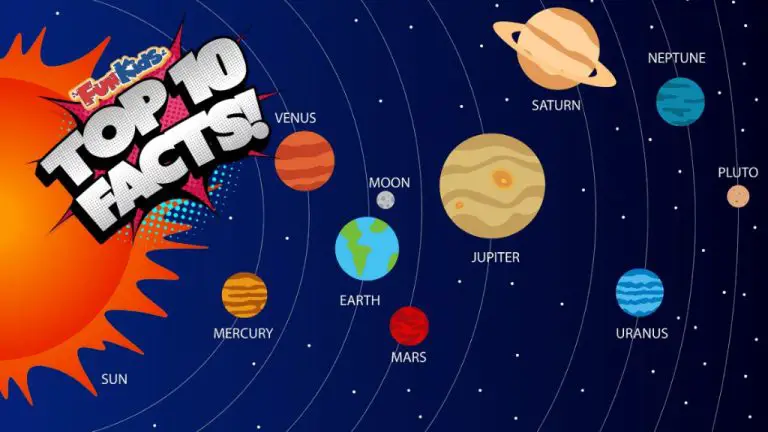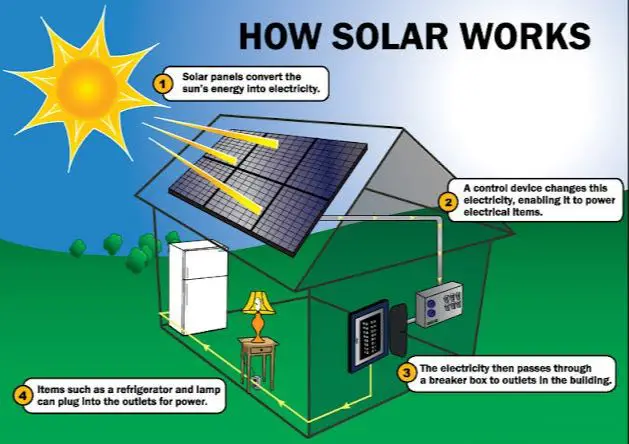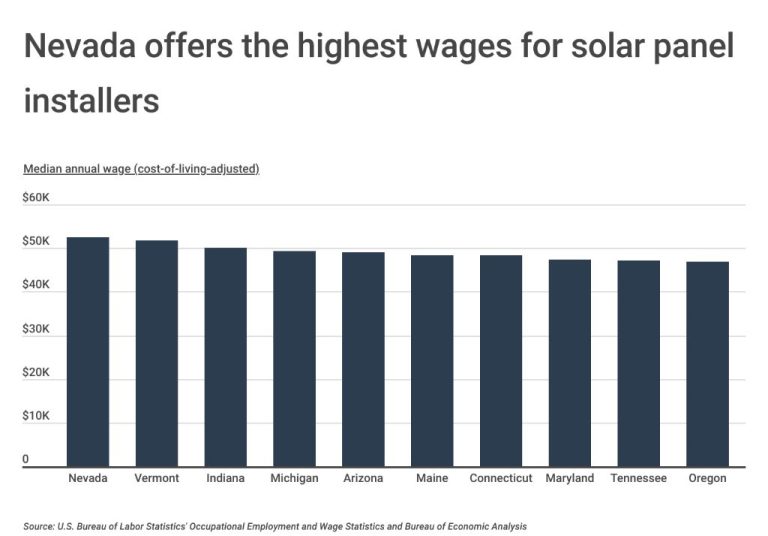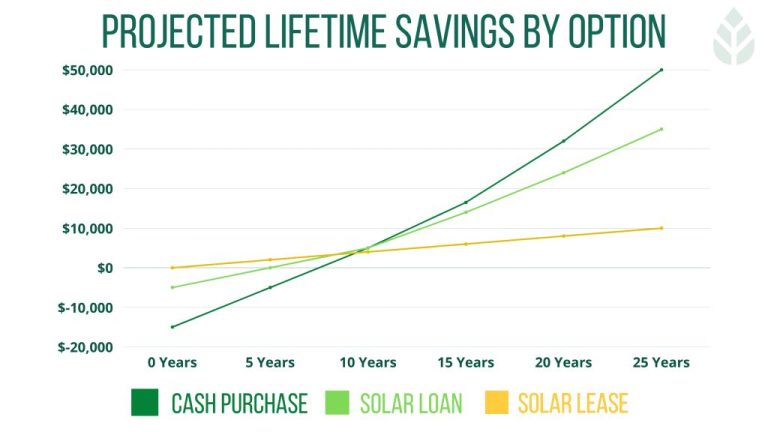How Solar Energy Works Step By Step?
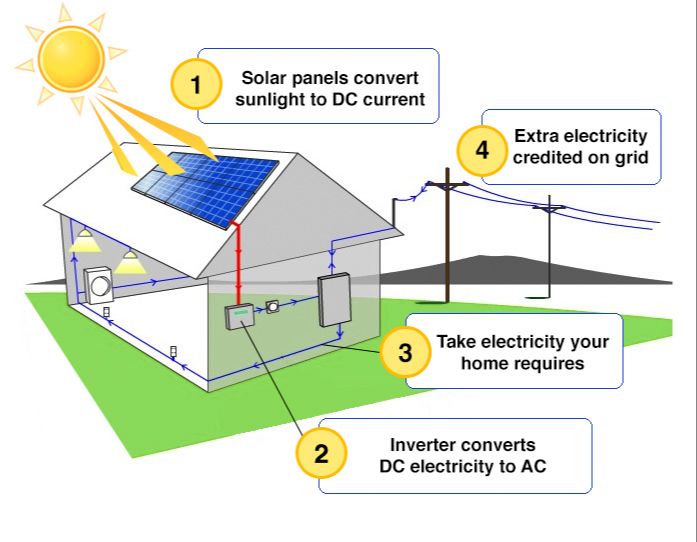
Solar energy refers to technologies that utilize energy from the sun to generate electricity or heat. The word “photovoltaic” comes from the Greek word for light, “photos,” and “voltaic,” meaning electric. Thus, the photovoltaic process converts sunlight directly into electricity.
The idea of harnessing energy from the sun dates back to the 7th Century B.C.E with the use of Magnifying glass technologies. In 1839, French physicist Edmond Becquerel first discovered the photovoltaic effect while experimenting with metal electrodes in a conductive solution. However, it was not until 1954 that researchers at Bell Laboratories in the U.S. produced the first modern silicon solar cell capable of converting enough sunlight into power to run everyday electrical equipment.
Today, solar energy provides a clean, renewable alternative to fossil fuels. Solar not only reduces greenhouse gas emissions, but it enhances energy security by relying on an infinite resource not subject to geopolitical tensions. With solar costs continuing to fall dramatically, solar energy has become one of the fastest growing renewable energy sources, supplying an increasingly significant share of electricity, heating, and more around the world.
How Solar Panels Work
Solar panels work through the photovoltaic effect, which is a process that converts sunlight directly into electricity. When sunlight hits the solar panel, it excites the electrons in the solar cells, causing them to flow and generate an electric current.
The key components in a solar cell that enable this process are:
- The semiconductor material, usually silicon, which absorbs photons from sunlight.
- The P-N junction between positive and negative semiconductor material, which generates an electric field.
- Metal contacts on the front and back that allow current to flow out of the solar cell.
When sunlight hits the solar panel, photons are absorbed by the semiconductor atoms, transferring their energy to the electrons and knocking them loose. The P-N junction creates an electric field that forces these electrons to flow in one direction, generating electricity. This electricity then travels out through the metal contacts to be used or stored.
So in summary, solar panels convert sunlight into electricity through the photovoltaic effect using special semiconductor materials arranged into solar cells. The key is absorption of photons, separation of charges, and collection of the electric current.
Types of Solar Panels
There are two main types of solar panels used in home installations: crystalline silicon panels and thin-film panels. Crystalline silicon panels are the most common, accounting for over 90% of the solar panel market.
Crystalline silicon panels are made from silicon wafers. There are two types: monocrystalline and polycrystalline. Monocrystalline silicon cells are made from a single crystal of silicon, making them more efficient with a typical efficiency range of 15-20% (https://aurorasolar.com/blog/solar-panel-types-guide/). Polycrystalline cells are made from multiple silicon crystal fragments melted together, with a slightly lower efficiency of 13-16%.
Thin-film solar panels are made by depositing layers of photovoltaic material onto substrates like glass or plastic. Thin-film panels are lighter and more flexible than crystalline silicon but less space efficient. The most common thin-film materials are cadmium telluride (CdTe), copper indium gallium selenide (CIGS), and amorphous silicon (a-Si). Thin-film efficiency ranges from 7-13% (https://www.energysage.com/solar/types-of-solar-panels/).
In terms of efficiency, monocrystalline silicon panels are the most efficient, followed by polycrystalline silicon and then thin-film panels. However, thin-film panels can be a good option when space is limited or flexibility is desired.
Solar Panel Installation
Installing solar panels on your home requires careful planning and execution. Here are the key steps involved in the installation process:
Mounting
Solar panels need to be securely mounted on your roof or ground using racking equipment. The mounting structure needs to be able to withstand wind, snow loads, and other environmental factors. Panels are usually mounted at an angle facing south to maximize sun exposure. Rooftop systems require additional watertight seals and flashings to prevent leaks.
Wiring
The solar panels are wired together into an array, with the DC electricity generated fed through wires down to an inverter. The inverter converts the DC current into AC to be used in your home. Proper wire sizing is critical to avoid energy losses. All wiring and electrical connections must meet local and national electrical codes.
Placement
Solar panels perform best when exposed to direct sunlight, oriented south. Factors like shade from trees or buildings and rooftop obstructions need to be considered when determining placement. Panels should be sited away from vents, chimneys, skylights and other rooftop structures. For ground mounts, available space and sun access are key.
Permits
Building permits are typically required for solar installations. Electrical permits may also be needed for wiring and connections. The solar company usually handles the permitting process but you should verify all required permits are obtained before work begins.
Connecting to the Electrical Grid
There are two main ways to connect your solar panel system to the electrical grid: on-grid and off-grid.
On-grid means your solar panel system is tied to the existing electrical grid. The solar panels generate electricity during the day that supplies power to your home. If your solar panels produce more electricity than your home is using, the excess electricity is fed into the grid. At night or when your solar panels aren’t generating enough electricity, your home pulls electricity from the grid.
With on-grid systems, your utility company will provide you with net metering. This allows your home’s electricity meter to spin backwards when you generate excess electricity, crediting you for that contribution.
Off-grid means your solar panel system is not connected to the electrical grid in any way. Your home relies completely on the solar panels to produce all the electricity it needs. Off-grid systems require batteries to store excess electricity for use at night. These systems are more complex to size and install.
Most homes today opt for on-grid solar connections to take advantage of net metering. This allows you to generate your own electricity from the sun during the day while seamlessly using the grid at night.
Solar Energy Storage
One key challenge with solar power is that it is an intermittent energy source that produces most of its electricity during the daytime when the sun is shining. For solar to provide consistent energy around the clock, energy storage solutions are often paired with solar panel systems. There are a few main ways that solar energy can be stored for later use:
Batteries are one of the most common and practical ways to store solar energy. When home solar panels produce more electricity than a household is using during the day, the excess electricity can be stored in batteries for use at night. Lithium-ion batteries like the Tesla Powerwall are a popular choice. Batteries allow solar panel owners to maximize self-consumption of their solar energy and provide backup power during grid outages. The high upfront cost of batteries is one downside, with typical costs ranging from $10,000-$20,000 installed. Prices are expected to decline over time as technology improves.1
Pumped hydro storage involves pumping water uphill to a reservoir when solar electricity supply exceeds demand. Then when energy is needed, the water can be released downhill to spin a turbine and generate electricity. This is currently the largest-capacity form of energy storage used with solar, but it requires specific geography and has high infrastructure costs.2
Solar thermal energy can also be stored for use when the sun isn’t shining. Solar collectors concentrate sunlight to heat a fluid like oil that can retain heat for a period of time. The stored thermal energy can then be used to create steam to drive a turbine and generator. Molten salt is another thermal storage medium used in some concentrating solar power plants.
Solar Panel Maintenance
Solar panels require regular cleaning and inspection, typically 2-4 times per year depending on environmental conditions, to maintain maximum efficiency and output (SolarReviews). The main maintenance tasks include:
Cleaning – Solar panels accumulate dirt, dust, pollen, bird droppings which can reduce efficiency by up to 25%. Panels are gently cleaned using water, mild detergent and a soft brush or cloth. Avoid abrasive materials that could scratch the glass surface (CNET).
Inspection – Visually inspect panels for any damage, wear and tear, vegetation overgrowth or shading. Check electrical connections are intact. Inspect mounts and frames for stability and corrosion. Tighten any loose parts.
Maximizing efficiency – Proper cleaning and inspections ensure solar panels are operating at peak efficiency. Check inverter operation and string voltages. Maintain vegetation to avoid shading. Update old equipment. Follow manufacturer maintenance recommendations.
With regular maintenance, solar PV systems can operate efficiently for over 25 years.
Solar Energy Economics
The upfront cost of installing a solar energy system can be high, ranging from $10,000 to $25,000 depending on the size of the system and your location. However, solar panels provide a return on investment over time in the form of lower or eliminated electricity bills.
Most homeowners see a complete payback on their solar panel system within 6 to 10 years. According to one analysis, the average payback period for solar panels in the U.S. is 8 years (https://www.forbes.com/home-improvement/solar/solar-panel-roi/). The payback period can be even faster in certain states with high electricity costs or robust solar incentives.
Various federal, state, and local incentives can help reduce the upfront cost of solar panels. The federal solar tax credit offers a 26% tax credit for systems installed in 2022-2023, which will step down to 22% for 2023-2024 systems. Many states and utilities also offer additional rebates and performance-based incentives to make solar power even more affordable.
After the payback period, solar panel systems can produce electricity essentially for free. This provides homeowners with 20+ years of free electricity from the sun. For grid-connected systems, any excess solar electricity produced can be sold back to the utility company at a premium rate through net metering programs.
With electricity prices constantly rising, investing in a solar energy system today can lead to increasing savings over the system’s lifetime. Analyzing the costs and incentives in your area is key to understanding the return on investment timeline.
Environmental Benefits
Solar energy provides numerous environmental benefits compared to fossil fuel-based energy sources. Most significantly, solar power generation produces zero greenhouse gas emissions during operation. According to the U.S. Energy Information Administration, solar energy technologies and power plants do not produce air pollution or carbon dioxide emissions when generating electricity (1). Solar energy can help reduce the carbon footprint of energy consumption, which is critical for mitigating climate change.
The development of renewable solar energy also supports sustainability and energy independence. Relying on the sun instead of finite fossil fuel resources reduces the depletion of non-renewable energy reserves. The U.S. Department of Energy notes that “as a renewable source of power, solar energy has an important role in reducing greenhouse gas emissions” (2). Solar power generation aligns with sustainable development goals and reduces the overall environmental impact of meeting energy needs.
Compared to fossil fuels, solar generation has minimal impacts on the environment and wildlife. Solar panel facilities can be designed and sited to minimize land use and habitat loss. Proper solar facility siting, planning, and mitigation can reduce potential environmental impacts (3). Overall, solar energy provides a clean, renewable energy source with greatly reduced environmental effects compared to conventional power generation.
The Future of Solar
The future looks bright for solar energy. As technology continues to improve, solar is projected to become even more efficient and cost-effective. According to the Solar Energy Industries Association (SEIA), solar could reach 30% of US electricity generation by 2030, up from just 3% in 2020 (source). Key factors driving growth include:
Improving solar panel efficiency – New solar cell technologies like perovskites and organic PV promise to push efficiency rates even higher. Commercial panels today typically operate at 15-22% efficiency. Emerging tech could boost this above 30%. Higher efficiency means more power output per panel.
Declining costs – Between 2010 and 2020, utility-scale solar costs fell 82%, and rooftop solar fell over 50% (source). As production scales up and technology improves, costs are projected to continue falling. The International Energy Agency (IEA) estimates utility-scale solar electricity could be 29–45% cheaper by 2030 (source).
Supportive policies – Government incentives like tax credits along with clean energy standards and targets will further boost solar adoption. The IEA projects renewables to make up over 80% of new power capacity additions through 2030 under current policies (source).
With such strong momentum, solar energy will continue disrupting the electricity sector and helping the transition to a clean energy system.

